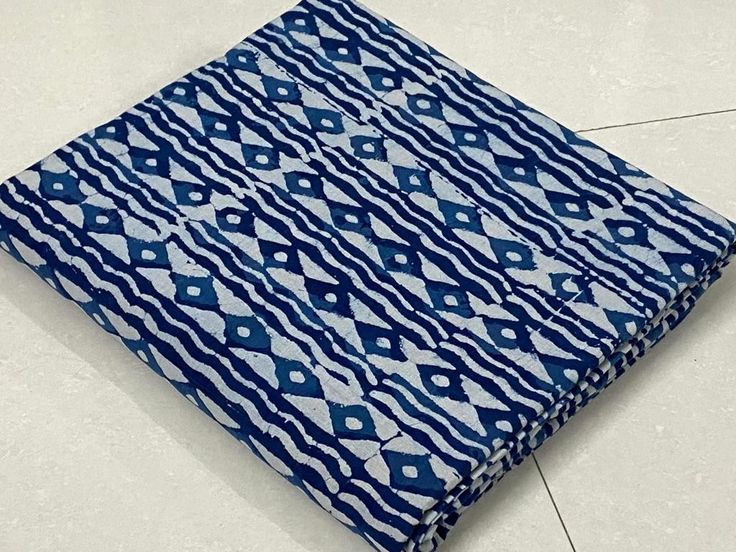Have you ever seen those beautiful fabrics with earthy tones, intricate patterns, and a touch of rustic charm? Chances are, you’ve come across the artistry of Bagru printing, a traditional textile art form that has been captivating people for centuries. And guess what? If you’re in Delhi, you’re not too far from the heartland of this beautiful craft!
In this blog post, we’re going to dive into the world of Bagru printed fabrics. We’ll explore its fascinating history, the unique techniques that make it so special, and why it continues to be loved and sought after even in today’s modern world. So, let’s unravel the story behind these beautiful textiles!
What Exactly is Bagru Printing?

Bagru printing is a traditional hand-block printing technique that originates from the village of Bagru in Rajasthan, India. Located near Jaipur (a city you might have heard of if you’re in Delhi!), this village has been a hub for this craft for generations. The artisans of Bagru have perfected this art form, creating stunning fabrics that are known for their natural dyes, earthy colors, and distinctive patterns.
Think of it as a form of wearable art, where each piece tells a story through its intricate designs and the hands that created it.
A Journey Through Time: The History of Bagru Printing

The history of Bagru printing is deeply rooted in the cultural and economic landscape of Rajasthan. It’s believed that this craft has been practiced for over 500 years! The printers, known as “Chhipas,” have passed down their skills and knowledge through generations.
Historically, Bagru printed fabrics were used for various purposes, including clothing for royalty, everyday wear for the common people, and even for religious and ceremonial purposes. The use of natural dyes made the fabrics skin-friendly and sustainable, which was a significant advantage in the past.
Over time, Bagru printing has evolved, adapting to changing tastes and demands while still staying true to its traditional roots. It has survived the test of time and continues to thrive, a testament to the enduring appeal of handcrafted artistry.
The Magic in the Making: Understanding the Techniques
What makes Bagru printing so unique and special? It’s the meticulous process and the use of traditional techniques that set it apart. Let’s take a look at the key steps involved:
1. Fabric Preparation:
The process begins with the preparation of the fabric, usually cotton or sometimes silk. The fabric is first washed and treated to make it ready to absorb the dyes. This often involves a process called “mordanting,” where the fabric is treated with a substance (like alum) that helps the dyes adhere and become colorfast.
2. Block Carving:
This is where the artistic aspect truly comes in. Skilled artisans carve intricate designs onto wooden blocks, typically made from teak wood. These blocks are like stamps, and each one holds a specific part of the overall pattern. The level of detail in these carvings is often remarkable.
3. Dye Preparation:
The magic of Bagru printing lies in the use of natural dyes derived from plants, minerals, and other natural sources. Some common colors and their sources include:
- Red: Madder root
- Yellow: Turmeric
- Indigo: Indigo plant
- Black: Iron and molasses
- Green: Indigo and turmeric mixed
These natural dyes not only give the fabric their beautiful colors but also add to their eco-friendly appeal.
4. Printing Process:
This is the heart of the Bagru printing process. The carved wooden blocks are dipped in the dye and then carefully stamped onto the fabric. The artisans apply the blocks with precision and skill, ensuring that the patterns align correctly. Different blocks are used for different colors and parts of the design.
5. Washing and Drying:
Once the printing is complete, the fabric is washed to remove excess dye and then dried in the sun. The washing process is also crucial for fixing the colors and ensuring their longevity.
6. Finishing:
Finally, the fabric undergoes a finishing process that might include calendering (pressing) to give it a smooth texture and enhance its appearance.
The Distinctive Features of Bagru Prints:
You can often identify Bagru printed fabrics by certain characteristic features:
- Earthy Color Palette: The use of natural dyes results in a predominantly earthy and warm color palette, including shades of brown, beige, red, indigo, and yellow.
- Geometric and Floral Motifs: Traditional Bagru designs often feature geometric patterns, floral motifs, and sometimes even animal figures.
- “Dabu” Technique (Mud Resist): In some Bagru prints, you might see the “Dabu” technique, where a resist paste made of mud, lime, and gum is applied to certain areas of the fabric before dyeing. This prevents the dye from reaching those areas, creating unique patterns.
- Handcrafted Feel: The slight variations and imperfections in the prints are a testament to the handmade nature of the craft, adding to its charm and authenticity.
The Modern Appeal of Bagru Prints:
In a world increasingly dominated by mass-produced goods, Bagru printed fabrics have found a strong and growing appeal. Here’s why they are so popular today:
- Sustainability: The use of natural dyes and traditional techniques makes Bagru printing an eco-friendly and sustainable craft. This resonates with conscious consumers who are looking for more sustainable fashion choices.
- Unique Designs: The handcrafted nature of the prints ensures that each piece is unique and tells a story. This offers a refreshing alternative to mass-produced, generic designs.
- Comfort and Breathability: Cotton fabrics, often used for Bagru printing, are comfortable and breathable, making them ideal for the Indian climate.
- Versatility: Bagru printed fabrics are used in a wide range of products, from clothing like kurtas, sarees, and dresses to home furnishings like bedspreads, cushion covers, and curtains.
- Supporting Artisans: By purchasing Bagru printed products, you are directly supporting the livelihoods of skilled artisans and helping to preserve a traditional craft.
- Timeless Aesthetic: The earthy tones and classic patterns of Bagru prints have a timeless appeal that transcends fleeting fashion trends.
Where to Find Bagru Printed Fabrics (Especially in Delhi):
If you’re in Delhi and want to experience the beauty of Bagru prints firsthand, here are some places you can explore:
- Local Markets: Markets like Dilli Haat, Janpath Market, and Sarojini Nagar Market often have stalls selling handcrafted textiles, including Bagru prints. You might find a variety of clothing and home decor items here.
- Boutiques and Designer Stores: Many boutiques and designer stores in areas like Khan Market, Hauz Khas Village, and Connaught Place showcase contemporary designs using traditional Bagru prints.
- Online Platforms: Numerous online platforms and e-commerce websites sell authentic Bagru printed fabrics and products. This offers a convenient way to browse and shop from the comfort of your home.
- Exhibitions and Craft Fairs: Keep an eye out for exhibitions and craft fairs that are often held in Delhi. These events provide a great opportunity to see a wide range of handcrafted products directly from the artisans.
Caring for Your Bagru Printed Fabrics:
To ensure that your Bagru printed fabrics last for a long time and retain their beauty, it’s important to care for them properly:
- Gentle Washing: Wash them gently by hand or on a delicate cycle in your washing machine.
- Use Mild Detergents: Avoid harsh chemicals and use mild, natural detergents.
- Wash Separately: Wash your Bagru printed garments separately or with similar colors to prevent color bleeding.
- Dry in Shade: Avoid direct sunlight when drying, as it can cause the colors to fade.
- Iron Carefully: Iron your fabrics on a low to medium heat setting.
The Future of Bagru Printing:
Bagru printing is a vibrant craft with a rich history, and its future looks promising. With increasing awareness about sustainable and handcrafted products, the demand for Bagru printed fabrics is likely to grow. Efforts are also being made to innovate with designs and adapt the craft to modern tastes while preserving its traditional essence.
Organizations and designers are working to empower the artisans, provide them with better working conditions, and promote their craft on national and international platforms. This ensures that the legacy of Bagru printing continues for generations to come.
In Conclusion
Bagru printed fabrics are more than just textiles; they are a testament to the skill, artistry, and cultural heritage of Rajasthan. From their rich history and meticulous techniques to their enduring modern appeal, these fabrics have a unique charm that resonates with people across the globe.
So, the next time you’re looking for something special, something with a story, consider exploring the world of Bagru prints. Whether you’re in Delhi or anywhere else, keep an eye out for these beautiful creations and experience the magic of tradition meeting contemporary style. You might just find your new favorite piece of wearable art!




